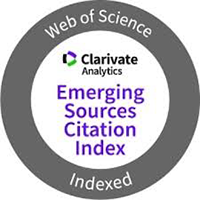Analysis of sport entrepreneurial intentions through linear models vs QCA
Keywords:
entrepreneurship, sport, students, university, Theory of Planned Behaviour.Abstract
The high rates of youth unemployment in Spain, have generated that entrepreneurship should be considered as a good career path for young graduates. Particularly, the sports sector is presented as a viable sector for young graduates to be an entrepreneur, although few studies about entrepreneurship have been carried out with this type of students. Therefore, it is the objective of this study to know which are the variables that predict entrepreneurial intention of the sport science students through the Theory of Planned Behavior and some socio-demographic variables (gender and work experience). For this purpose, a sample of 121 students from the last year of the degree in Sport Sciences of the University of Valence has been analyzed through the administration of a structured questionnaire. Two different analysis methodologies were used: linear regression model and a fuzzy-set qualitative comparative analysis (fsQCA). The results of the linear regression were able to explain 68% of the entrepreneurial intentions, highlighting as main variables the professional attraction (β=.70), the control of perceived behavior (β=.15) and work experience (β =.13). Taking into account the results of fsQCA, none of the conditions are sufficient for the presence of entrepreneurial intentions. Based on the sufficiency analysis, five conditions explain 76% of the entrepreneurial intentions. The three most important conditions were high level of PA, EC, male gender and work experience; high levels of PBC, male gender, work experience and low levels of EC; high levels of PA, SN, work experience and low levels of EC (explaining 50%, 24% and 27% respectively) of entrepreneurial intentions. In general QCA is more explanatory than LM. Finally, practical implications for sport universities are presented.Downloads
References
Ajzen, I. (1991). The theory of planned behavior. Organizational behavior and human decision processes, 50(2), 179-21.
Autio, E., H. Keeley, R., Klofsten, M., Parker, G. y Hay, M. (2001). Entrepreneurial intent among students in Scandinavia and in the USA. Enterprise and Innovation Management Studies, 2 (2), 145-160.
Bairner, A. (2006) Political Unionism and Sporting Nationalism: An Examination of the Relationship Between Sport and National Identity Within the Ulster Unionist Tradition. Identities: Global Studies in Culture and Power, 10(4): 517-535. doi: 10.1080/714947401
Ball, S. (2005). The importance of entrepreneurship to hospitality, leisure, sport and tourism. Hospitality, Leisure, Sport and Tourism Network, 1(1), 1-14.
Beynon, M., Jones, P., y Pickernell, D. (2016). Country-based comparison analysis using fsQCA investigating entrepreneurial attitudes and activity. Journal of Business Research 69(4), 1271-1276.
Eng, S. y Woodside, A. (2012). Configural analysis of the drinking man: Fuzzy-set qualitative comparative analyses. Addictive Behaviors, 37, 541–543.
Ghiasy, F. G., Hosseini, J. F., Malekmohammado, I., y Hosseini, M. (2009). Factors influencing the entrepreneurship in Iran’s agricultural cooperatives. Australian Journal of Basic and Applied Sciences, 3(2): 1170–1176.
González-Serrano, M. H., Crespo, J., y Pérez-Campos, C. (2017). Influencia de la experiencia laboral y del entorno social próximo en las intenciones de emprender de los estudiantes de ciencias de la actividad física y el deporte. Journal of Sports Economics & Management, 7(1), 14-29.
González-Serrano, M. H., Crespo, J., Pérez-Campos, C., y Calabuig, F. (2017). The importance of developing the entrepreneurial capacities in sport sciences university students. International Journal of Sport Policy and Politics, 4, 1-16. doi: 10.1080/19406940.2017.1316762
Henry, C., Foss, L., y Ahl, H. (2016). Gender and entrepreneurship research: A review of methodological approaches. International Small Business Journal, 34(3), 217–241.
Kraus, S., Ribeiro-Soriano, D., y Schüssler, M. (2017). Fuzzy-set qualitative comparative analysis (fsQCA) in entrepreneurship and innovation research–the rise of a method. International Entrepreneurship and Management Journal, 1-19.
Liñán, F. (2008). Skill and Value Perceptions: How Do they Affect Entrepreneurial Intentions? International Entrepreneurship and Management Journal, 4(3), 257-272.
Liñán, F., y Chen, Y. W. (2009). Development and Cross‐Cultural application of a specific instrument to measure entrepreneurial intentions. Entrepreneurship Theory and Practice, 33(3), 593-617.
Marín, L., Rubio, A. y Sánchez-Mora, M.I. (2015). El impacto del entorno del estudiante en sus intenciones de crear una empresa cuando finalice sus estudios. Lan Harremanak. Revista de Relaciones Laborales, 32(1), 504-526. doi: 10.1387/lan-harremanak.15443
Moriano, J. A., Palací, F. J., y Morales, J. F. (2006). El perfil psicosocial del emprendedor universitario. Revista de Psicología del Trabajo y de las Organizaciones, 22(1), 75-100.
OECD (2017). Youth Unemployment Rate. Extraído el 5 de Noviembre de 2017, https://data.oecd.org/unemp/youth-unemployment-rate.htm
Ollila, S. y Williams-Middleton, K. (2011). The Venture Creation Approach: Integrating Entrepreneurial Education and Incubation at the University. International Journal of Entrepreneurship and Innovation Management, 13(2), 161–178. doi: 10.1504/IJEIM.2011.038857
Peña, I., Guerrero, M., González-Pernía, J. L. (2016). Global Entrepreneurship Monitor : informe GEM España 2016. Universidad de Cantabria, Cantabria, España.
Prado-Gascó, V. J. y Calabuig, F. (2016). La medición de la calidad de servicio en eventos deportivos: modelos lineales vs. QCA. Journal of Sports Economics & Management, 6(3), 126-136.
Ragin, C. (2008). Redesigning social inquiry: Fuzzy sets and beyond. Chicago, USA: University of Chicago Press.
Ratten, V. (2012). Sport entrepreneurship: challenges and directions for future research. International Journal of Entrepreneurial Venturing, 4(1), 65-76.
Ruiz, J., Rojas, A., y Suárez, A. (2008). Actitudes de los estudiantes universitarios de Andalucía ante la creación de empresas. Cádiz, España: Servicio de Publicaciones de la Universidad de Cádiz.
Sánchez, J. y Licciardello, O. (2012). Gender differences and attitudes in entrepreneurial intentions: the role of career choice. Journal of Women's Entrepreneurship and Education, 1-2, 7-27.
Schmitz, A., Urbano, D., Dandolini, G. A., de Souza, J. A., y Guerrero, M. (2017). Innovation and entrepreneurship in the academic setting: a systematic literature review”. International Entrepreneurship and Management Journal, 13(2), 369-395. doi: 10.1007/s11365-016-0401-z
Shane S. (2008). The Illusions of Entrepreneurship: The Costly Myths that Entrepreneurs, Investors, and Policy Makers Live by. New Haven, CT: Yale University Press.
Shinnar, R., Hsu, D., Powell, B. y Zhou, H. (2017). Entrepreneurial intentions and start-ups: Are women or men more likely to enact their intentions? International Small Business Journal, 1-21. doi: 0266242617704277
Tsordia, C. y Papadimitriou, D. (2015). The role of theory of planned behavior on entrepreneurial intention of Greek business students. International Journal of Synergy and Research, 4(1), 23-37. doi: 10.17951/ijsr.2015.4.1.23
Valencia, A., Montoya, I. y Montoya, A. (2016). Intención emprendedora en estudiantes universitarios: Un estudio bibliométrico. Intangible Capital, 12, 884-922. doi: 0.3926/ic.730
Vieira, M. y Vidal, J. (2006). Tendencias de la Educación Superior Europea e implicaciones para la orientación universitaria. Revista española de orientación y psicopedagogía 17(1), 75-97.
Wu, C.W., y Huarng, K.H. (2015). Global entrepreneurship and innovation in management. Journal of Business Research, 68(4), 743–747.
Downloads
Published
Issue
Section
License
Authors who submit to this journal agree to the following terms:
- Author(s) keep copyright and guarantee to the journal the right to be the first publication of the work as licensed under Creative Commons Attribution-Noncommercial-ShareAlike 4.0 International as initial publication in this journal.
- Author(s) can establish additional agreements for non-exclusive distribution of the version of the work published in the journal (for example, to an institutional archives or to publish it in a book), with an acknowledgment of its initial publication in this journal.
- It is allowed and authors are encouraged to disseminate their work electronically (e.g, in institutional open archives or on their own website) before and during the submission process, as it can lead to productive exchanges, as well as a citation earlier and more of published work (See the Effect of Open Access).












